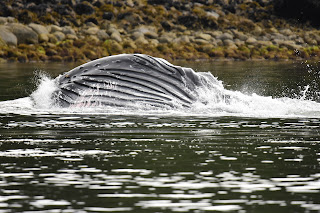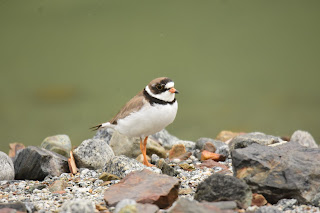From Thomas Bay onwards, there were lots of cool things to see, but I'm going to put them all into one post. We explore the west side of Thomas bay, a place I had never been before, and walked over to Dry Bay, which isn't very deep (as you might have guessed) and dries up at low tide. It has some great beaver ponds and really nice meadows. The flowers were out. We also had some sun on us.
You can see the mountains on the east side of the bay pretty well from there too.

From Thomas Bay we went to Farragut Bay. People live here, there are lots of cabins in the flat, and we met one resident right off the bat, as he was shirtless and on the beach with no boat. We anchored and paddled in and learned that he had been trying to get to his fishing boat (a nice seiner) and his kayak had sunk under him and he had to swim to shore. Since nobody comes in the bay very often, maybe once a week or so, he was lucky to have us find him, about two hours after going for a swim. The bugs were pretty bad and he was getting eaten, but eaten alive! I can't imagine swimming more than a very short ways in this water. We dropped him off at his boat and then went for a paddle up the river, and then over to another cabin with two sailboats sitting in front of it. There, we met the second resident, who was 80 years old, and had been living there for 40 years. He was a retired aerospace engineer and had a big plot of land that he was protecting, and told us about how the animals were very friendly. And then we saw some! A moose and a bear! So we went a little closer to look. I'd like to go back and interview him and film it. I think people with Uncruise would be interested.

From there we were in Fredrick Sound, which is the province of the Whale. We saw a few.
And then on to Port Houghton. I love this bay. We found a porcupine while waiting for the tide at the narrows to the Salt Chuck, and he was on a log, great for photos.
Here he looks like an old man leaning on a walking stick. I think he might be a wizard.
In the back bay we found a Black Bear munching on some greens. It was pretty oblivious to our approach, but finally looked up.
Also I found a Red-Headed Sapsucker, drinking the sap from an alder. It would run its bill up and down the peeled bark area and collect sap.
And a Spotted Sandpiper high steeping through the grass on a log up the river.
From there we went to Windham Bay and hiked up the creek to the old mine site. There are ruins all over there.
We climbed and climbed, and up about 3 miles and 2400 ft we got to the top of the ridge. It was pretty terrible brush but when we got above the trees it was nice.
And we could look down on the other side, on Endicott Arm!
The next day we went over to Endicott Arm by boat and found a bear guarding a dead seal on the beach
And a lot of Ice. So much ice that we couldn't make it more than halfway up the fjord. But we did make it to Ford's Terror.
In Ford's Terror there are really high cliffs and lots of waterfalls, so we set about looking at them.
This one is in a cleft that you can barely fit the boat into.
I also found a type of fern I had never seen before. it has a lot of similarities to a Lady Fern, but it also looks like a sword fern, except the leaves are not as dark. I've never seen it elsewhere.
From Ford's Terror we went to Port Snettisham. In there we found a lot of Brown Bears. Many were ok with our approach and we got pretty close.
These two seemed to be about ready to mate. There was the larger golden one which was a male and the smaller brown one was female, and they touched a few times.
How do you tell if a bear is male or female? Its pretty difficult most of the time, but this bear was showing. Mostly you see which way they pee. If its forward, its a male, if its back, its female.






































 ead, we headed north
to Thomas Bay! It was raining pretty hard all day and the wind was
at our backs (unusual) and we made really good time sailing on up,
but it was still pretty late when we arrived in Scenery Cove. On our
way in we saw a brown bear with a big piece of machinery. Mike Justa
(my companion for this trip) mentioned that it was the typical
alaska: "Brown Bears and broken down boats." As we
approached to get a closer look at the bear, another bear popped out.
It was a black bear with two little cubs. It walked out onto the
beach, then looked up and saw the brown bear, and turned right around
and boogied out of there. No sense hanging around with something
that will eat her cubs.
ead, we headed north
to Thomas Bay! It was raining pretty hard all day and the wind was
at our backs (unusual) and we made really good time sailing on up,
but it was still pretty late when we arrived in Scenery Cove. On our
way in we saw a brown bear with a big piece of machinery. Mike Justa
(my companion for this trip) mentioned that it was the typical
alaska: "Brown Bears and broken down boats." As we
approached to get a closer look at the bear, another bear popped out.
It was a black bear with two little cubs. It walked out onto the
beach, then looked up and saw the brown bear, and turned right around
and boogied out of there. No sense hanging around with something
that will eat her cubs.






